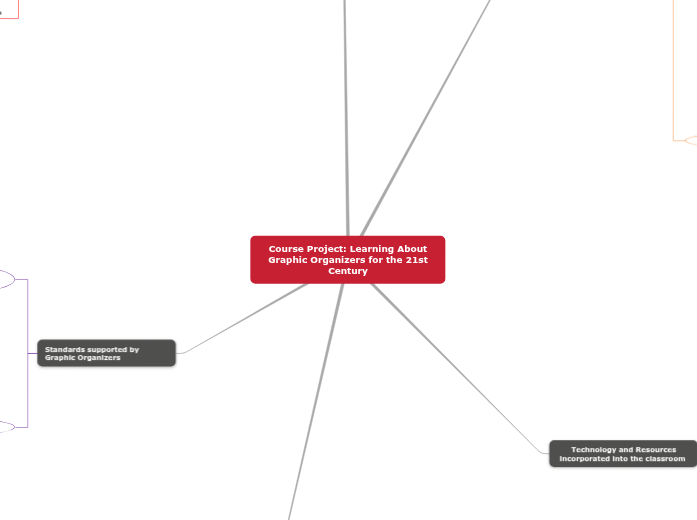Course Project: Learning About Graphic Organizers for the 21st Century
Graphic Organizers
Types of graphic organizers I'll use in my classroom
Flowchart EGO
bubbl.us
Simple
Spicynodes
Subtopic
Mindomo
Multi-featured
Mindmeister
Multi-featured
Slickplan
Templates
Giffy
Edistorm
tags
recommendations
sticky notes
Outlines
Thinklinkr
Text2Mindmap
Free hand drawing
Scribblar
Free software
cMAP
download
How GO can be used as tools for learning
•Brainstorm ideas
•Manipulate and organize data
•Visualize information
•Explore relationships between data points
•Vocabulary improvement
•Problem solving
•Assessment
•Tool to help with the writing process
•Tool to support communication and collaboration skills
•Integrate Critical thinking skills from Bloom’s taxonomy
• Remembering
• Understanding
• Applying
• Analyzing
• Evaluating
• Creating
Strategies to incorporate GO into classroom
Class Activity
Teacher computer and Projector
Smart Slate
Group Activity
Vocabulary practice
Flowchart a biological process
Research and answer real world challenge
Individual Activity
Practice concepts
Review concepts
Assess understanding
Rationale for using GO in the classroom
•Support collaboration and communication skills
•Improve editing skills
•Teach outlining skills
•Provide opportunities to use Web 2.0 technology skills
•Cause students to be engaged and active learners
•Create meaningful opportunities to learn
•Promotes a deeper understanding of the concepts
•Are open-ended allowing for creative and innovative solutions
•Encourages students to take ownership in their learning
•Provides an opportunity to explore Metacognition patterns
•Supports differentiation
•assume, infer, analyze, prioritize, and judge
•brainstorm, connect, create, and elaborate
Classroom Overview and Philosophy
Grade level
High School
Subject area(s)
Biology
Chemistry
Instructional Philosophy
Please click note icon.
Learning is active
Questions are important- be curious
All students are unique- RESPECT is essential
Teamwork and collaboration are key ingredients
Communication between home and school is vital
Classroom goals and focus
Curriculum
California Biology Standards
•Cell Biology
•Genetics/ Biotechnology
•Ecology
•Evolution
•Human Physiology/ Health
California Chemistry Standards
•Atomic and Molecular Structure
•Chemical Bonds
•Conservation of Matter and Stoichiometry
•Gases and their Properties
•Acids and Bases
•Solutions
•Chemical Thermodynamics
•Nuclear Processes
•Organic and Biochemistry
•Reaction Rates
•Chemical Equilibrium
ITSE/NETS Technology Standards
•Demonstrate creativity and innovation
•Communicate and collaborate
•Conduct research and use information
•Think critically, solve problems, and make decisions
•Use technology effectively and productively
Skills
Independent Learners
Demonstrate the use of a variety of tools for self-evaluation and goal-setting
Critical Thinkers
Demonstrate higher level thinking skills, such as applying, analyzing, and evaluating data
Organize data using Graphic Organizers
Creating innovative solutions to real world challenges
Academic Achievers
Meet or exceed state, district and school standards and competencies
Develop technology literacy skills
Responsible Citizens
Demonstrate self-discipline, as reflected by positive behavior
Demonstrate awareness of Health, Environmental, and Global issues
Effective Communicators
Read, write, listen and speak proficiently
Manage information and ideas through a variety of modes of communication
Utilize technology tools (Web 2.0) to develop collaboration skills
Standards supported by Graphic Organizers
NETS•S technology standards
Demonstrate creativity and innovation
Communicate and collaborate
Conduct research and use information
Think critically, solve problems, and make decisions
Use technology effectively and productively
California State Standards
California State Investigation and Experimental Standards
1a- Select and use appropriate tools and technology to perform tests, collect data, analyze relationships, and display data (Graphic Organizer)
1. m Investigate a science-based societal issue by researching literature, analyzing data, and communicating the results
1.l Analyze situations and solve problems that require combining and applying concepts from more than one area of science
Most Biology State Standards
Most Chemistry State Standards
Integration of 21st Century Skills
Critical Thinking and Problem Solving
Through content
Keep Bloom's Taxonomy in mind
Use Graphic Organizers
Patti Drapeau's differentiation verbs
Creativity and Innovation
Offer activities that are open-ended and address real world problems
Patti Drapeau's creativity verbs
Communication and Collaboration
Incorporate Web 2.0 tools in as many activities as possible
Technology and Resources incorporated into the classroom
Technology tools
Web 2.0
Electronic Graphing Organizers
Wikis
Blogs
Social bookmarking
Internet
Microsoft Office
Resources
Class computers
Computer lab
Handheld Renaissance responders
Administration
Colleagues
Students
